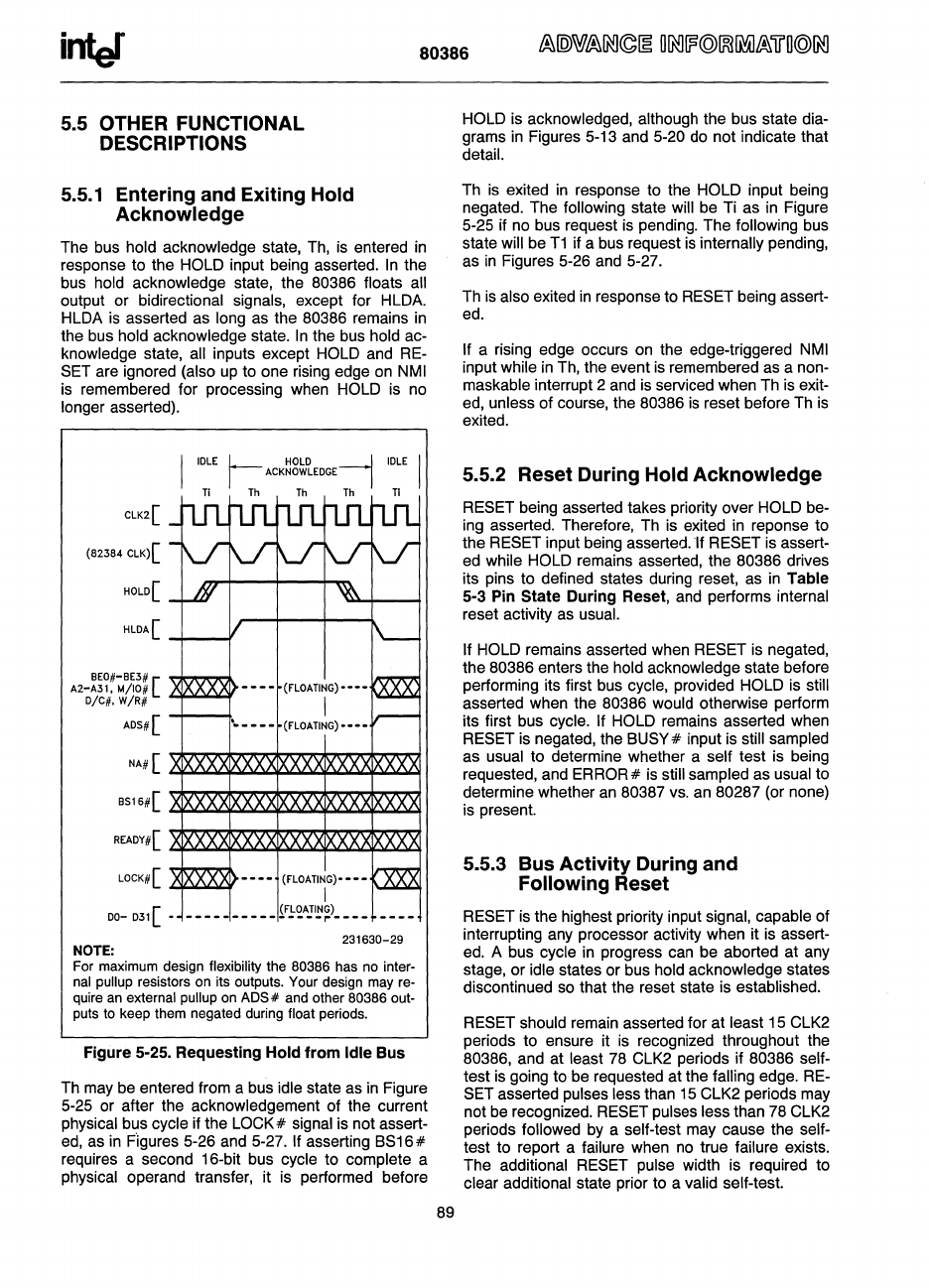
80386
5.5 OTHER FUNCTIONAL
DESCRIPTIONS
5.5.1
Entering and Exiting Hold
Acknowledge
The bus hold acknowledge state,
Th,
is
entered
in
response to the HOLD input being asserted.
In
the
bus hold acknowledge state, the
80386 floats all
output or bidirectional signals, except for HLDA.
HLDA
is
asserted as long as the 80386 remains
in
the bus hold acknowledge state.
In
the bus hold ac-
knowledge state, all inputs except HOLD and
RE-
SET are ignored (also
up
to one rising edge
on
NMI
is
remembered for processing when HOLD
is
no
longer asserted).
r
ACK~g~~EDGE~
10LE
n
Th Th Th
n
10LE
(82384
CLK>[
8EO#-8E3# [
A2-A31.
M/IO#
L~~~
o/c#.
w/R#
-
AOS#[
LOCK#[
~~:.cJ(
----
(FLOATING)·---
I
(FLOATING)
---------------~----
00-031[.
231630-29
NOTE:
For maximum design flexibility the 80386 has no inter-
nal pullup
resistors on its outputs. Your design may re-
quire an external
PUIIUP
on ADS # and other 80386 out-
puts to keep them negated during float periods.
Figure 5-25. Requesting Hold from Idle Bus
Th
may
be entered from a bus idle state as
in
Figure
5-25 or after the acknowledgement of the current
physical bus cycle if the
LOCK# signal is not assert-
ed,
as
in
Figures 5-26 and 5-27. If asserting BS16#
requires a second 16-bit bus cycle to complete a
physical operand transfer, it is performed before
89
HOLD
is
acknowledged, although the bus state dia-
grams
in
Figures 5-13 and 5-20
do
not indicate that
detail.
Th
is
exited
in
response to the HOLD input being
negated. The
following state will be Ti as
in
Figure
5-25 if no bus request
is
pending. The following bus
state will
be
T1
if a bus request
is
internally pending,
as
in
Figures 5-26 and 5-27.
Th
is
also exited
in
response to RESET being assert-
ed.
If a rising edge occurs on the edge-triggered
NMI
input while
in
Th, the event
is
remembered as a non-
maskable interrupt 2 and
is
serviced when Th is exit-
ed, unless of course, the 80386
is
reset before Th
is
exited.
5.5.2 Reset During Hold Acknowledge
RESET being asserted takes priority over HOLD be-
ing asserted. Therefore, Th is exited
in
reponse to
the
RESET input being asserted. If RESET
is
assert-
ed while HOLD remains asserted, the 80386 drives
its pins to defined states during reset,
as
in
Table
5-3 Pin State During Reset, and performs internal
reset activity as
usual.
If HOLD
remains asserted when RESET
is
negated,
the
80386 enters the hold acknowledge state before
performing its first bus cycle, provided
HOLD is still
asserted when the
80386 would otherwise perform
its first bus cycle.
If HOLD remains asserted when
RESET is negated, the BUSY # input
is
still sampled
as usual to determine whether a self test
is
being
requested, and ERROR#
is
still sampled as usual to
determine whether
an
80387
vs.
an 80287 (or none)
is
present.
5.5.3
Bus
Activity During and
Following Reset
RESET
is
the highest priority input signal, capable of
interrupting any processor activity when it
is
assert-
ed.
A bus cycle
in
progress
can
be aborted at any
stage, or idle states or bus hold acknowledge states
discontinued
so
that the reset state is established.
RESET
should remain asserted for at least 15 CLK2
periods to ensure it
is
recognized throughout the
80386, and at least
78
CLK2 periods if 80386 self-
test
is
going to be requested at the falling edge.
RE-
SET asserted pulses less than
15
CLK2 periods may
not
be
recognized. RESET pulses less than 78 CLK2
periods
followed
by
a self-test may cause the self-
test to report a failure when
no
true failure exists.
The additional
RESET pulse width is required to
clear additional state prior to a
valid self-test.


















